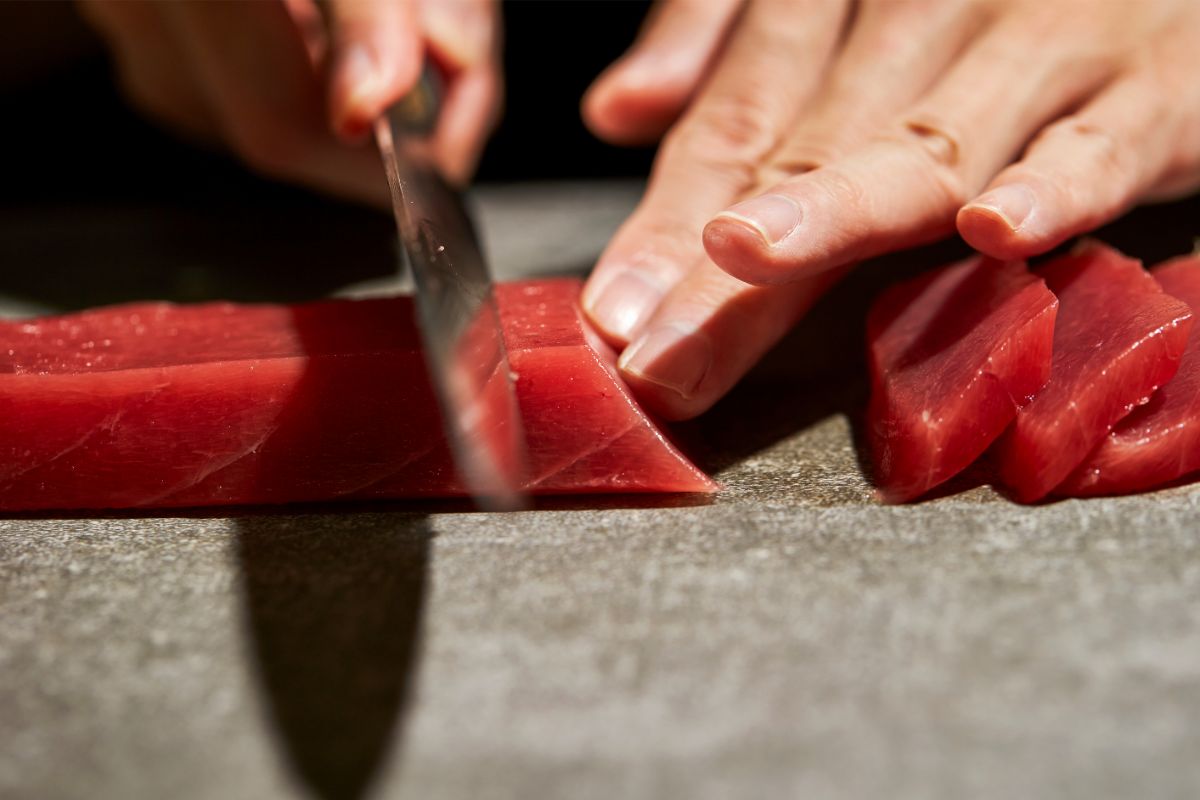If you have never tried tuna before, it is quite tricky to know if it is the kind of thing that you will like.
You will hear plenty of people talk about how much they love it, but then just as many people will mention that they hate it too.

Because of this, the prospect of trying tuna for the first time can be pretty intimidating. Tuna is a food that has been around for a long time as well, it has been sold packaged and canned, and in plenty of other forms as well.
There is also a massive variety of dishes that are made using tuna as well, because of this, if you find out you like tuna, this can open you up to a wide variety of new dishes to try.
You can use tuna to make a salad, you can have tuna with pasta, you can even turn tuna into patties and serve it that way.
However, you have your tuna, it is a versatile source of protein, and it is also pretty healthy if you eat it in moderation.
While we will go more in depth on the specifics of how tuna tastes, let’s give a quick overview here.
Tuna does have a unique taste, the main reason for this is that in spite of being a fish, tuna does not have a strong fishy smell, or a fishy taste either.
The taste of tuna is quite similar to other meats, with a noticeably salty and creamy taste. However, if you want to learn more about tuna, keep reading for all the details!
The Taste Of Tuna
As we referenced earlier, tuna can be eaten in a wide variety of different ways, and because of this, defining the taste of tuna is not that simple since there is a range of different flavors the tuna can have.
This is because tuna is quite good at taking on other flavors that have been added to it, for example, it is commonly seasoned with mustard and spices.
However, it will still have a core flavor that is slightly buttery and creamy with a more umami and salty flavor as well. However, this flavor is not strong and can be overpowered.
One of the most common forms of tuna you will find is canned tuna, and it is worth pointing out that this type of tuna is more likely to have a noticeably oily taste, and this is because of how it is packaged.
Tuna that is canned will be preserved using a salt and oil brine. However, tuna which is packaged in other methods aside from canning, will still have a more salty taste, but much less oily.
If you want the least salty type of tuna, then look out for fresh tuna. This kind of tuna will have a much more bright and fresh taste, and this is because not much salt has been added aside from traditional salt.
It will also not have had an oil brine used on it, so this is the least oily way to enjoy tuna. A fresh tuna will also have the most mild taste and this means it is a perfect base for adding any spices or seasonings you want to!
The Texture Of Tuna
If you have never had tuna before, and you want to know about how it is to eat, as well as knowing about the taste, it is also important to know about the texture.
This is especially true for something with a unique texture like tuna does! This is because whatever type of tuna you are enjoying, it has quite a unique texture compared to other types of fish.
For example, if you are eating canned tuna, this has a texture that is closer to a shredded chicken rather than a fish. This texture is soft and will melt in your mouth!
Because of the texture of canned tuna, it is often used in salads, or as a sandwich filling because of just how versatile it is.
If you are looking for a delicious protein that has a soft texture that works well in different dishes, then tuna is going to be one of the best options!
Canned tuna has quite a different texture compared to fresh or packaged tuna which is a lot more meaty, and will vary depending on how the tuna has been treated since it was caught!
How To Prepare Tuna
While there are some people who are happy to just enjoy their tuna straight out of the can, most people do prefer to change their tuna or prepare it in a certain way to make it more interesting to eat.
Because of this, we will go through everything you need to know when it comes to preparing tuna to change how it tastes.
And this is not just talking about the different cooking styles, but also about how you should be storing it as well!

How To Store Tuna
So, if you are buying your tuna fresh, or just dealing with any leftovers, you will want to know the proper way to store your tuna.
For some types of tuna this will be simple, but for others it will be a little more difficult.
For example if you are working with unopened canned tuna, then this is simple since it can just be stored in the cupboard since it is packaged in a brine and a can meaning it does not need to be stored in special conditions.
However, for more fresh types of tuna, then you will need to store it in a more specific way. For example, your fresher tuna will need to be stored in a fridge at temperatures between -2 and 0 Celsius.
And, when you are putting tuna in your fridge, you will not want it to be left exposed. You will instead want it to be in an airtight container after being wrapped in plastic wrap or foil.
You will also get better results if you wipe your tuna using a paper towel to get rid of any excess moisture.
For a raw or fresh tuna, this will start to spoil in your fridge after just a couple of days. Because of this, you want to use it as soon as possible.
If you let your tuna go bad, it will start to make your fridge smell awful and it will eventually be unsafe to eat as well!
If the tuna is cooked and is just leftovers, you again want to use an airtight container and then store it in a cool part of your fridge and try to eat it between 2 and 3 days after cooking.
Has Your Tuna Gone Bad?
Luckily it is pretty easy to tell if your tuna has gone bad. This is because if your tuna is still good to eat, it will not have a strong taste or smell when uncooked.
This is because, as mentioned previously, tuna does not have a distinctly fishy smell, but if it starts to smell very fishy, then it has gone bad. Also, your tuna will change color eventually.
The meat will begin to look more lifeless with cooler gray undertones. You only want to eat tuna with red undertones. And for canned tuna, if it smells too metallic, or has passed the use by date, do not risk it!
Can You Freeze Tuna?
If you want your fresh tuna to last longer, then freezing it is a great idea. However, before freezing you want to ensure your tuna has been rinsed with cool water and then dried using a paper towel.
Also, let it acclimate to the fridge temperature before you freeze it! When freezing, keep in a freezer bag or an airtight container.
Plastic is actually preferable to glass since it will not react to any temperature changes, and if you use metal, this will impact the taste!
However, if you are freezing a whole fresh tuna, then you will want to ensure you have removed the guts before you freeze it.
This is because the guts go bad first, so if you get rid of them, it will stop the rest of the meat from getting tainted by them.
We recommend to only freeze your tuna for about 6 months, however, it will start to lose some of its flavor as well as some nutritional value after it has been frozen for 3 months so keep that in mind!
How To Defrost Tuna
It is not too difficult to defrost tuna, but you want to give it time. So, you want to put your tuna in its container in the fridge overnight, this will let it defrost a lot quicker.
This also ensures that bacteria will not form on it either. You want to avoid defrosting your tuna in water or on the counter, this can change the properties of the tuna and even make it go bad.
You also definitely want to avoid refreezing your tuna as well!
Changing The Taste Of Tuna
If you have tried tuna before, but you did not like it, there is a good chance that you did not have it prepared in a way that you like.
However, there are plenty of different ways to prepare tuna to make it easier to enjoy. So, if you had a bad experience with tuna once, this does not necessarily mean that you will not like any dishes that contain tuna.
This is partially because since tuna has such a mild taste it absorbs other flavors well!
For one of the most common and popular ways you can prepare tuna, especially if it is canned or packaged, we recommend adding some mustard, mayonnaise, and your favorite spices.
This gives it a much more intense and fresh flavor that makes it much easier to enjoy, but still unique and shows off the good qualities of tuna.
You can also add a variety of other seasonings to your tuna to make it interesting like lemon, pepper, garlic, and rosemary. Any combination of these will work amazingly.
A more simple way to make your tuna more interesting is to add it into other dishes. For example, you can add the mixture we just mentioned into a sandwich to use it as a filling.
A lot of people also love using tuna in a casserole since when it is warmed up like this it is delicious.
You can also bake it with teriyaki seasoning, or mix it into a lemony or cheesy pasta! Tuna is also a great filling for soups, stews, and fish cakes as well!
Summary
Hopefully this guide has given you all the information you need on tuna and what it tastes like. If you like the sound of how we have described tuna, then it is likely that you will like it.
If you want to start eating seafood, but you find the fishy taste overpowering, using tuna is a great way to acclimate yourself so you can grow to love other similar types of seafood later on!
We also recommend closely paying attention to our guidance on storage since poorly storing your tuna can drastically alter its quality!
- How To Reheat A Cheesesteak - November 5, 2023
- What Are Three Must Have Kitchen Knives? - September 22, 2023
- How To Protect Edges Of Pie Crust - June 15, 2023








